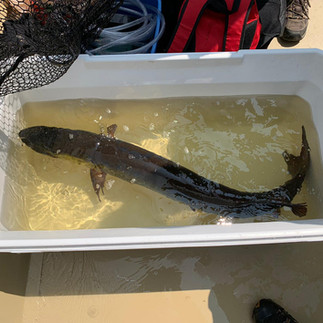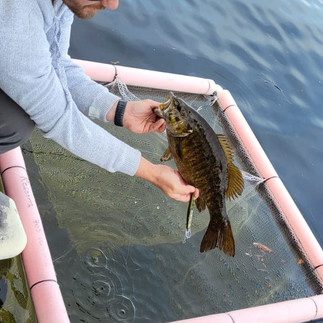- grahamdraby
- Aug 21, 2023
- 3 min read
In late June and early July, Kurt Smith (DFO research technician) and Dr. Jake Brownscombe (DFO research scientist) led the download of the 60 acoustic receivers we have deployed across Upper and Lower Stoney, and Clear Lake. The receivers are our 'listening stations' that have been in position since last summer, listening for our fish tagged with acoustic transmitters. Deploying, retrieving, and downloading receivers is the most labour intensive and technically challenging part of the field work for a project like this. Each receiver has to be hidden below the surface and anchored to the bottom. In our case, most receivers were suspended off the bottom with a float, in all sorts of depths and locations. Ranging from 100 feet of water in Upper Stoney to shallow, weedy areas that were only 8 feet deep.
Kurt and Jake have perfected a new way of retrieving the receivers, using ActiveTarget Live Sonar (a Lowrance toy) to visualize the receiver and float suspending it from the bottom. They then use an underwater drone with an arm and claw to hook a rope onto the anchor. Once that's done, a bit of (human) muscle on board the research vessel is used to pull the whole thing up off the bottom. To keep the receivers in place, we are using 85 lb concrete anchors that we made ourselves, so it's a good workout for Jake's team to pull those into the boat.
The good news: the receivers contained a huge amount of data (detections of our tagged fish). The bad news: the receivers contained a huge amount of data. Really, it's mostly good news that everything is working well, but the management and analysis of huge datasets are the key bottleneck with fish tracking projects. We're already at >5 million detections of our tagged fish from our network of receivers. The vast majority of fish we've tagged were only tagged recently and their tags will last years. Which means that when we go to download the receivers again next summer, I'm guessing we'll be north of 20 million lines of data. It's a good problem to have, and our team has the expertise needed. For the PhD student on the project, Amber Fedus, wrangling these data be a wonderful learning opportunity over the next few years.

(Above) Summary of number of fish tagged to date, number of detections of those fish, the number of unique animals detected so far on our receivers, and the number of unique stations on which each species has been detected. Note: the vast majority of the animals were only tagged a few weeks before the receivers were downloaded.
One fun (or not so fun) note from the receiver downloads: a couple of the receivers were completely covered in zebra mussels, after just one year in the water (see picture below). For some reason, these happened to be the ones in Clear Lake. There were zebra mussels on receivers elsewhere, but the Clear Lake ones had by far the heaviest coverage. If anyone reading this knows why that's the case, or has observed the same trend in this system, let me know. I've been asked whether a coating of mussels will prevent the receiver from 'hearing' the fish transmitters. The answer is no, but it might reduce the receiver's performance a bit (i.e., it might have slightly impaired hearing). Some folks working on Lake Erie are working to quantify how big of a problem zebra mussels are for receiver performance.

(Left) Image of an acoustic receiver, completely covered in zebra mussels after one year of deployment in Clear Lake. Inset is an imagine of what the receiver looked like a year ago. Photo courtesy of Kurt Smith.
Finally, on an unrelated note: thanks to Tricia Mason from Global News Peterborough for having Amber and I on their morning show last week to talk about this project. You can see our interview here. https://globalnews.ca/video/9904720/aquatic-research-program-providing-experiential-learning-for-trent-university-students/



















